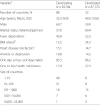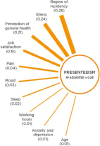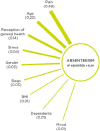1. Abrams HK. A short history of occupational health. J Public Health Policy. 2001; 22(1):34–80. DOI:
10.2307/3343553. PMID:
11382089.
2. Mills PR, Kessler RC, Cooper J, Sullivan S. Impact of a health promotion program on employee health risks and work productivity. Am J Health Promot. 2007; 22(1):45–53. DOI:
10.4278/0890-1171-22.1.45. PMID:
17894263.
3. Schultz AB, Edington DW. Employee Health and Presenteeism: A Systematic Review. J Occup Rehabil. 2007; 17(3):547–79. DOI:
10.1007/s10926-007-9096-x. PMID:
17653835.
4. Addley K, Boyd S, Kerr R, McQuillan P, Houdmont J, McCrory M. The impact of two workplace-based health risk appraisal interventions on employee lifestyle parameters, mental health and work ability: results of a randomized controlled trial. Health Educ Res. 2014; 29(2):247–58. DOI:
10.1093/her/cyt113. PMID:
24399261.
5. Naydeck BL, Pearson JA, Ozminkowski RJ, Day BT, Goetzel RZ. The impact of the highmark employee wellness programs on 4-year healthcare costs. J Occup Environ Med. 2008; 50(2):146–56. DOI:
10.1097/JOM.0b013e3181617855. PMID:
18301171.
6. Goetzel RZ, Henke RM, Tabrizi M, Pelletier KR, Loeppke R, Ballard DW, et al. Do Workplace Health Promotion (Wellness) Programs Work? J Occup Environ Med. 2014; 56(9):927–34. DOI:
10.1097/JOM.0000000000000276. PMID:
25153303.
7. Shi Y, Sears LE, Coberley CR, Pope JE. Classification of Individual Well-Being Scores for the Determination of Adverse Health and Productivity Outcomes in Employee Populations. Popul Health Manag. 2013; 16(2):90–8. DOI:
10.1089/pop.2012.0039. PMID:
23013034.
8. Sears LE, Shi Y, Coberley CR, Pope JE. Overall Well-Being as a Predictor of Health Care, Productivity, and Retention Outcomes in a Large Employer. Popul Health Manag. 2013; 16(6):397–405. DOI:
10.1089/pop.2012.0114. PMID:
23480368.
9. Merrill RM, Aldana SG, Garrett J, Ross C. Effectiveness of a workplace wellness program for maintaining health and promoting healthy behaviors. J Occup Environ Med [Internet]. 2011; 53(7):782–7. DOI:
10.1097/JOM.0b013e318220c2f4.
10. Conn VS, Hafdahl AR, Cooper PS, Brown LM, Lusk SL. Meta-analysis of workplace physical activity interventions. Am J Prev Med. 2009; 37(4):330–9. DOI:
10.1016/j.amepre.2009.06.008. PMID:
19765506.
11. Berry LL, Mirabito AM, Baun WB. What’s the hard return on employee wellness programs? Harv Bus Rev. 2010; 88(12):104–12. PMID:
21188899.
12. Halpern MT, Dirani R, Schmier JK. Impacts of a smoking cessation benefit among employed populations. J Occup Environ Med. 2007; 49(1):11–21. DOI:
10.1097/JOM.0b013e31802db579. PMID:
17215709.
13. Bowling NA, Eschleman KJ, Wang Q. A meta-analytic examination of the relationship between job satisfaction and subjective well-being. J Occup Organ Psychol. 2010; 83(4):915–34. DOI:
10.1348/096317909X478557.
14. Wright DW, Beard MJ, Edington DW. Association of health risks with the cost of time away from work. J Occup Environ Med [Internet]. 2002; 44(12):1126–34. DOI:
10.1097/00043764-200212000-00006.
16. Melhorn JM, Wilkinson L, Riggs JD. Management of musculoskeletal pain in the workplace. J Occup Environ Med [Internet]. 2001; 43(2):83–93. DOI:
10.1097/00043764-200102000-00003.
17. WHO. WHO | Workplace health promotion: the workplace: a priority setting for health promotion. WHO. World Health Organization; 2010.
18. Aldana SG, Merrill RM, Price K, Hardy A, Hager R. Financial impact of a comprehensive multisite workplace health promotion program. Prev Med. 2005;40(2):131–7.
19. Burton WN, Chen C-Y, Conti DJ, Schultz AB, Edington DW. Measuring the relationship between employees’ health risk factors and corporate pharmaceutical expenditures. J Occup Environ Med [Internet]. 2003; 45(8):793–802. DOI:
10.1097/01.jom.0000079090.95532.db.
20. Ozminkowski RJ, Goetzel RZ, Wang F, Gibson TB, Shechter D, Musich S, et al. The savings gained from participation in health promotion programs for Medicare beneficiaries. J Occup Environ Med. 2006; 48(11):1125–32. DOI:
10.1097/01.jom.0000240709.01860.8a. PMID:
17099448.
21. Milner K, da Silva R, Patel D, Salau S. How do we measure up? A comparison of lifestyle-related health risk factors among sampled employees in South African and UK companies. Glob Health Promot. 2016.
22. Kirsten W, Karch RC. Global perspectives in workplace health promotion. Occupational Health. 2010;11(22).
23. Mills P. The development of a new corporate specific health risk measurement instrument, and its use in investigating the relationship between health and well-being. Environ Heal. 2005; 4:1. DOI:
10.1186/1476-069X-4-1.
25. Di Cesare M, Khang Y-H, Asaria P, Blakely T, Cowan MJ, Farzadfar F, et al. Inequalities in non-communicable diseases and effective responses. Lancet. 2013; 381(9866):585–97. DOI:
10.1016/S0140-6736(12)61851-0. PMID:
23410608.
26. Boutayeb A, Twizell E, Achouayb K, Chetouani A, Achouyab K, Chetouani A, et al. The burden of non communicable diseases in developing countries. Biomed Eng Online. 2004; 3(1):20. DOI:
10.1186/1475-925X-3-20. PMID:
15222886.
27. Dean B, Aguilar D, Shapiro C, Orr WC, Isserman JA, Calimlim B, et al. Impaired health status, daily functioning, and work productivity in adults with excessive sleepiness. J Occup Environ Med. 2010; 52(2):144–9. DOI:
10.1097/JOM.0b013e3181c99505. PMID:
20134351.
28. Demerouti E, Le Blanc PM, Bakker AB, Schaufeli WB, Hox J. Present but sick: a three- wave study on job demands, presenteeism and burnout. Career Dev Int. 2009; 14(1):50–68. DOI:
10.1108/13620430910933574.
29. Kucharczyk ER, Morgan K, Hall AP. The occupational impact of sleep quality and insomnia symptoms. Sleep Med Rev. 2012; 16(6):547–59. DOI:
10.1016/j.smrv.2012.01.005. PMID:
22401983.
30. Musich S, Hook D, Baaner S, Spooner M, Edington DW. The association of corporate work environment factors, health risks, and medical conditions with presenteeism among Australian employees. Am J Health Promot. 2006; 21(2):127–36. DOI:
10.4278/0890-1171-21.2.127. PMID:
17152252.
31. Burton WN, Chen C-Y, Conti DJ, Schultz AB, Edington DW. The association between health risk change and presenteeism change. J Occup Environ Med. 2006; 48(3):252–63. DOI:
10.1097/01.jom.0000201563.18108.af. PMID:
16531829.










 PDF
PDF Citation
Citation Print
Print



 XML Download
XML Download